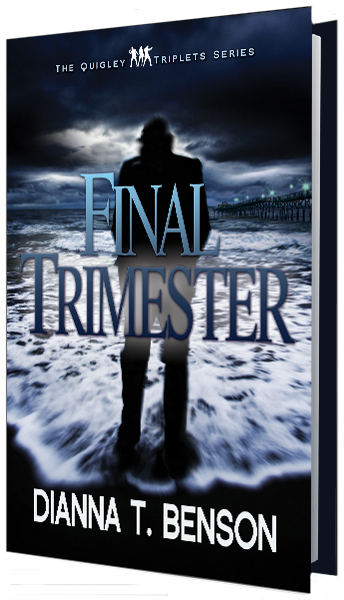Trauma Call/Domestic Violence: Dianna T. Benson, EMT
Posted by dtbAdmin on Jul 15, 2014 in Blog, Medical/EMS | 0 comments
“EMS 6, Stabbing, TAC Channel 12”
Responding to a domestic disturbance call, my partner and I park our ambulance in front of an upscale home over a million dollars. Not atypical – EMS is too often called out to the rich on domestic violence.
“Did you know the power company turns off this zip code for lack of pay more than any other in the state?” I ask my new partner.
“Yep. Idiots living beyond their means. No wonder they’re so stressed out and hurt each other.”
At the front door, we join a fire crew, as three cops enter the house, all three with weapons drawn.
“Scene isn’t safe?” I ask.
“Not sure,” the last cop answers then trails his two buddies.
The fire crew of four hangs back with me and my partner.
“Was the door unlocked?”
“Yup,” one of the firefighters answers me.
After five long and boring minutes of standing around on the lawn in the dark of night, I radio in to dispatch. “EMS 6. Standing by outside residence. Any updates from PD on scene?”
“Yes. Scene is secure. PD is with victim.”
“Copy that.” I roll the front of our loaded stretcher into the house.
In the family room, I find one officer bent over a body, the other two talking with an agitated man.
I kneel at the woman’s other side. She’s supine on the carpet, her lapped hands pressed to her lower abdomen and covered in blood.
“Ma’am?” I touch her shoulder in comfort.
My patient blinks at me then flutters her eyes closed.
“Can you tell me your name?”
“Judy,” she whispered in a pained voice.
I brush my hand over hers. “Judy, are you hurt anywhere other than here?”
“Don’t know,” she mumbles.
“Judy?” I stare into her eyes, mascara smudged underneath them. “Can you move your arms down at your sides?”
She does.
My partner hands me trauma scissors, a stack of 5X9 sterile gauze pads, and an occlusive dressing. As I rip open the gauze packages, my partner hooks up the patient to our cardiac monitor and focuses on assessing and monitoring vital signs.
“How can I help?” one of the firefighters asks me.
“Perform a rapid trauma assessment.”
“You got it.” He starts at the head.
With the trauma scissors, I cut Judy’s shirt, exposing the wound. Noting no debris other than blood, I cover the gushing horizontal wound—thin but long—with one sterile gauze pad after another, and apply direct pressure with my palms. “Did a knife do this, Judy?”
“He did.”
“With a knife?”
“Steak knife.”
“I see nothing else,” the firefighter informs me at the patient’s feet.
I nod. “Thanks.”
I glance at the monitor screen for Judy’s vital signs. Her heart rhythm is normal, but her blood pressure is too low, pulse too high, indicating she’s headed to shock due to blood loss. My guess is she’s bleeding internally, the knife blade sliced an organ or two, maybe the abdominal aorta. Regardless of what’s injury, she needs a surgical team.
I look at my partner. “We gotta go. Now.”
“Give me the switchblade,” one of the cops says, alarm in his tone. “Sir, you’re just making things worse for yourself.”
“Past time to go,” I whisper to my partner, a rush of panic clogging my throat.
“No kidding,” he whispers back, wide-eyed.
“Get out of here,” one of the cops says to us.
“What’d you say to them?” the agitated man shouts.
“You don’t want a murder charge, do you? The EMS crew needs to get her to the hospital.”
The cops deal with the perpetrator, as my partner readies the stretcher. I blanket the dozen or so bloody gauze pads with a towel.
Inside the moving ambulance, I raise the foot of the stretcher to treat for shock. I cover Judy’s mouth and nose with a non-rebreather oxygen mask and turn on the O2 to 15 lpm. Since none of her organs eviscerated, I do not apply an occlusive dressing. Instead, I add additional 5X9s and a fresh towel and instruct the one firefighter who joined us en route to press his hands over it for direct pressure. I insert an IV saline bolus and consider administering morphine or fentanyl for pain.
“More cops dispatched to scene,” my partner yells back from the driver’s seat. “Guy stabbed one of the cops and fled the scene on foot.”
I look down at my patient. She doesn’t indicate she heard those disturbing words.
“We’re ten minutes out,” my partner yells back at me.
I pick up the radio. “Wake Med ED, this is EMS 6.”
“Go ahead EMS 6.”
“We are enroute with a thirty-eight year old female. Left lower quadrant adnominal stab wound. No evisceration. BP 82 over 56. Heart rate 173. Non-rebreather at 15 liters per minute. Legs elevated for shock treatment. Place OR on stand by. ETA 10 minutes.”
“See you in 10. Wake Med out.”
“EMS 6 out.”




